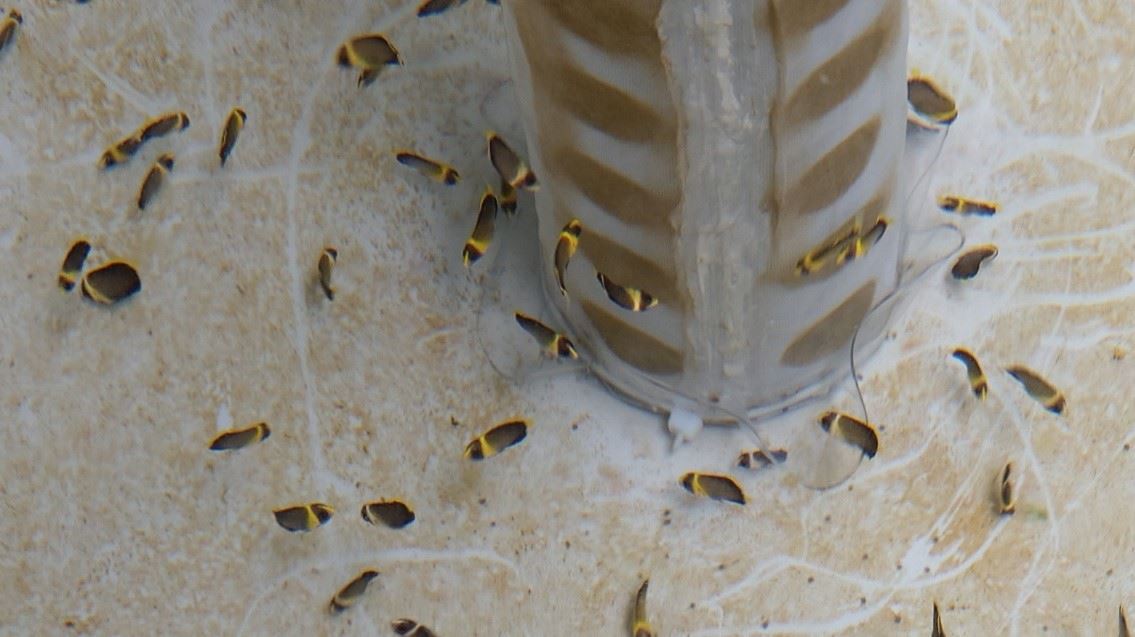News
Advancing mass production technology of the shining Golden Butterfly- Chaetodontoplus septentrinalis
- PostDate:2022-03-01
The Fisheries Research Institute announced that , it has successively established Chaetodontoplus septentrinalis breeding, pairing, and natural spawning technics, a bait biological culture technic, and a fry mass production technic. In 2021, with more rigorous bait sequencing and management technology, the success rate of seedlings has been maintained at 2-5% and the goal of establishing a "commercial mass production" model has been achieved, which both improves Taiwan’s market competitiveness and effectively alleviates the pressure of artificial fishing on wild populations.
According to the Fisheries Research Institute, Chaetodontoplus septentrinalis belongs to the genus purpuridae, which is also known as the northern spiny fish, but commonly called Dianchuang, Bianshengku, or Suanlanzai in Penghu. Living in coral reef areas, and feeding on algae, coral polyps, and sponges, this fish is mainly distributed in southern Japan, the western Pacific waters from South Korea to the Malay Peninsula, and the waters around Taiwan. It is the most representative fish species exported from Penghu as a seawater ornamental fish. A breeding colony of Chaetodontoplus septentrinalis consists of one male and multiple females, the male is usually the strongest, and can be transformed from a dominant female in the colony. This species is brightly colored, with variable stripes, and no two Chaetodontoplus septentrinalis fish have the same body color and stripes. Its trade name in the seawater ornamental fish market is Golden Butterfly, often referred to as G. Butterfly.
As explained by the Fisheries Research Institute, the juvenile Chaetodontoplus septentrinalis with a body size of 5 to 6 cm was once one of the main exporters of Taiwan’s marine ornamental fish to the United States. However, Taiwan’s natural marine resources have been greatly reduced due to habitat destruction and over-harvesting. At present, the retail price of a wild adult Chaetodontoplus septentrinalis in Taiwan is NTD 1,500 per fish, and that of an artificial juvenile fish of 4 to 5 cm is about NTD 1,200. Therefore, the development of artificial breeding technology for Chaetodontoplus septentrinalis should focus on its high economic value and create effective methods to alleviate the survival pressure on wild populations caused by artificial fishing.
The Fisheries Research Institute started an experiment to breed wild Chaetodontoplus septentrinalis in 2015. In 2016, the seedlings were successfully induced to spawn by hormone injection. In 2019, the seedlings were able to spawn naturally without hormone treatment. Then, in 2020, exploration of the biological sequence of the nursery bait for Chaetodontoplus septentrinalis was initially completed. This year, the research and development achievements of nursery technology were reconfirmed, and the success rate of the nursery was 2-5%. The results show that the brood fish of Chaetodontoplus septentrinalis could be successfully paired and spawned for more than 6 months in an artificial environment. Moreover, if the fry is fed with specific bait organisms with good water quality management, they are expected to reach 5 cm in length in four months, which meets the mass production specifications of the industry.
The Fisheries Research Institute pointed out that the development of "advancing Chaetodontoplus septentrinalis mass production technology" will prolong the spawning period with stable breeding technology, and provide a stable supply of high-quality fertilized eggs. Moreover, the strict feeding sequence and management will effectively improve the success rate of breeding seedlings, which is a major process in the breeding technology of Chaetodontoplus septentrinalis. A long production period and ideal fry survival rate will be beneficial to the operation of fish farms and enhance Taiwan’s market competitiveness. The findings of the Fisheries Research Institute show that the future development of the breeding industry of Chaetodontoplus septentrinalis in Taiwan is quite promising.

Figure 1. Brightly colored Chaetodontoplus septentrinalis with variable stripes

Figure 2. A 50-day-old juvenile Chaetodontoplus septentrinalis can eat the algae attached on the tank wall


